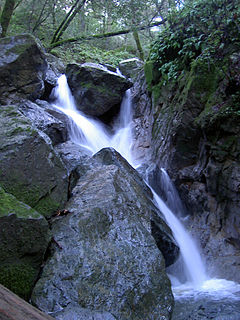Sugarloaf Ridge State Park
| Sugarloaf Ridge State Park | |
|---|---|

Waterfall in the park
|
|
| Location | Sonoma and Napa counties, California, U.S. |
| Nearest city | Santa Rosa, California |
| Coordinates | 38°26′42″N 122°30′08″W / 38.4449105°N 122.5022032°WCoordinates: 38°26′42″N 122°30′08″W / 38.4449105°N 122.5022032°W |
| Area | 4,020 acres (1,630 ha) |
| Operated by | Team Sugarloaf |
Sugarloaf Ridge State Park is a state park in Northern California, U.S.A.. Located in the Mayacamas Mountains north of Kenwood, the park straddles the boundary between Sonoma and Napa counties. The park contains the 2,729 feet (832 m) Bald Mountain and the headwaters of Sonoma Creek including a 25-foot (8 m) tall seasonal waterfall. The park is also home to the volunteer-run Robert Ferguson Observatory. Camping, picnicking, horseback riding, mountain biking, stargazing, fishing and hiking are common attractions of Sugarloaf. The park boasts 25 miles of trails with trails ranging from less than a mile to 8.8 miles, and elevation gains reaching 2,500 feet.
The ridge has two main peaks, the western one being 1,939 feet (591 m) above sea level and eastern one being 2,265 feet (690 m). The East peak contains an extensive microwave antenna. This site was featured in several articles of the Napa Valley Sentinel.
Sugarloaf Ridge was one of the first parks to close under the California State Parks plan to close up to 70 of its 278 parks due to budget cuts. The closures were deemed necessary to achieve an $11 million reduction in the next fiscal year 2011/12, that amount increasing to $22 million in the following fiscal year 2012/13. The park was reopened by Team Sugarloaf in June 2012 to restore access to camping and hiking trails.
The park's official address is 2605 Adobe Canyon Road, Kenwood, CA 95452.
The Wappo Indians were the first known inhabitants of the region, settling on along the Sonoma Creek 1500 years ago. They relied on various resources of the region especially acorns and berries, and are known for their farming and basketry abilities. Spaniards attempted to takeover the area in 1823, failing. Later, the cholera epidemic dwindled the numbers of the Wappos, who were ultimately relocated to Indian reservations by the American government.
...
Wikipedia

